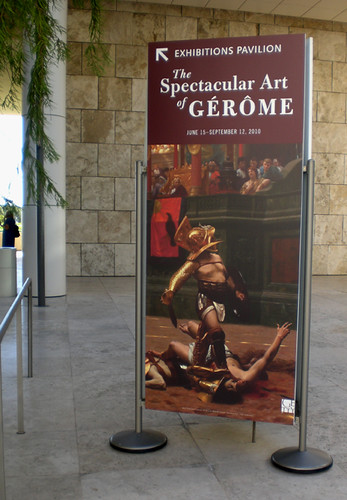
Visited the Getty yesterday to see the Gerome exhibition, on view through September 12th.
Fantastic show.
I've seen a number of these paintings in person, at the Tate Museum, in London, 3 years ago (Orientalism exhibition, January 2007) and, throughout my childhood, at the Walters Art Museum in Baltimore (permanent collection). This, however, is a more comprehensive survey of his subjects and media, including sculpture.
Primary emphasis is placed on Gerome's oil paintings, his primary artistic milieux, spanning over six decades from portrait commissions through historical tableaux, mythological and religious subjects and Orientalist fantasies.
Gerome may have been one of the first 19th century French painters to take full advantage of photography in preparation for his work, from the 1840s through the early years of the twentieth century.
Several rooms are devoted to photography and printmaking, both with reference to Gerome's use of photography to plan his paintings, and to how photography of the completed art formed a basis for derivative lithographic prints and coffee-table art books made from the paintings, which added to his fame, wealth, and criticism at the time for being too 'commercial'.
Then as now, some critics considered the use of photographic references 'cheating'. One can't imagine how any artist could create works with this degree of pictorial complexity and accuracy without the use of photography, but art critics, of any day and age, require something to write about.
I'd have liked to have seen drawings and more preparatory studies. If there were any drawings at all, I missed them. A few painted 'sketches' are included.
The paintings' composition, color, patterns, use of light and attention to detail are mind boggling. Gerome's drafting and painting technique and the anatomical perfection of the portraits and figures in most of the work is amazing and exciting.
I'm sure his work reflects all of the prejudices of upper-class French social strata toward the 'exotic', 'hot-blooded' cultures portrayed. One would expect that, it didn't detract in the slightest from my enjoyment of his imagination in composing tableaux of Roman, Moorish, Egyptian and Turkish worlds. I'm fascinated not only by what artists paint, but by the filters that form their judgment of what is worthy to be painted and how the narrative should be presented to viewers...the lens that informs us. One sees similarly coupled juxtapositions in Bodmer's studies of Native American tribal life, modeled (by Bodmer or his publisher) after Neo-Classical French historical painting by David and Ingres.
Looking at Gerome's subjects from the context of contemporary American values, his depictions of women are far fewer than of men, and almost always emphasize their sexuality and objectification, entertainment or slave value. One senses his closest friends were men and wonders if he so much as knew any women artists.
A bust of French actress Sarah Bernhardt, towards the end of the exhibition and the end of his prolific artistic life, seems almost to have been created by another artist. One remembers that Mucha and the Art Nouveau movement dovetailed with the end of traditional Academic French painting. One realises too that Gerome's work was overshadowed by Impressionism, through the last decades of the nineteenth century, and appreciates his wisdom in sticking to what he excelled at, rather than jumping ship for the next critically acclaimed art movement.
Not everything Gerome made 'worked', or at least, what remains to be seen of it. Attempts to tint marble busts with natural looking pigments to create a life-like aura may have faded unevenly. What's left looked slightly cheesy. The uniform, cool brown tint applied to Bernhardt's elaborately coifed 'do', for example, looks a bit like a dead possum. Perhaps a century ago the pigments on the statue were more varied, hadn't faded or gained a layer of soot, and gave a life-like impression.
If you have a chance, hope you'll see this show. Few artists of any age drew, painted, or could put together a composition better than Gerome. His Orientalist paintings, such as 'The Snake Charmer' (detail above)are among my favorites.

